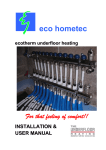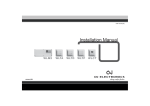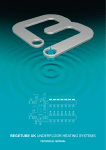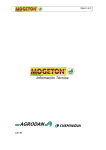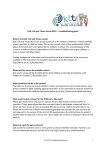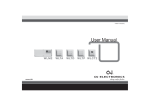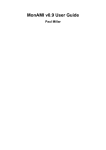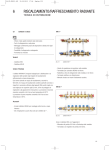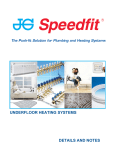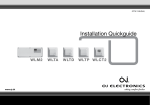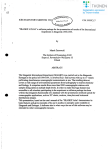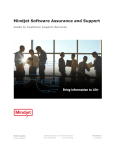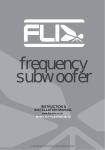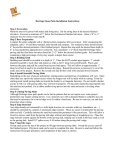Download Compact Installation Manual
Transcript
Underfloor Heating Technical & Installation Manual 11 Burrenreagh Road Castlewellan Co. Down BT31 9HH Tel no: 028 437 70 700 Fax no: 028 437 78 404 Contents Section 1. Design CAD Drawings 2. Placing & hanging the manifold. 3. Installing the Underfloor heating pipes. 3-4 5 6-7 4. Floor structures. 8 5. Filling & pressurising system. 9 6. Starting up your system. 10 7. Additives & inhibitor. 10 8. Floor finishes suitable for floor heating. 11 9. Room Control. 11 10. Quick Commisioning Guide 11. Fault finding & problem solving. 12. Electrical Schematics. 2 page 12-13 14 14-19 1. DESIGN CAD DRAWING. The CAD design drawing is calculated in accordance with BS EN 1264 using HT2000 software and is based on the following detail provided: • Building u values/ Heat loss. • Heat Source. • Floor coverings. • Manifold positions. • Floor & elevation plans. Pipe lengths, pipe spacing’s and manifold circuits are produced based on the heat load of the building and taking in account the: • Thermal resistance of floor coverings (R value m2 K/w). • kPa pressure loss. • Flow rates. • Target room temperatures. • Maximum design flow temperatures. • Maximum floor temperatures. 3 Reading your CAD drawing. The CAD pipe layout drawing provides all the essential information needed for correctly installing the underfloor system. Please ensure the drawing corresponds with the project site conditions with any deviation being notified to the engineer as soon as possible. Important points: • • • 4 The positioning of permanent fixtures (kitchen units, baths, toilets etc) must be confirmed prior to pipe installation. The room stat positions indicated are purely to show which room/area has a thermostat. Final positions should be in accordance with IEE regulations and manufacturers instructions. Keep pipework 100mm in from all partitions, perimeter walls and permanent fixtures. 2. Placing & Hanging of Manifold Place & install the manifold according to the position agreed in the design specification. Although the manifold has a built-in pump with a low noise level, we advise not to install the unit close to a bed, in the bedroom or behind a timber partition wall. Any noise could be increased due to the ‘sound box’ effect created by the timber partitioning. Generally the manifold is hung 600mm above the floor and should be hung level. Ample space should be given to the manifold in order that the unit can be serviced in the future. In particular on the left hand side of the unit, facing it, there should be a minimum of 200mm to allow for the regulation valve probe to be installed and removed if and when required. The rubber washers should be placed on both sides of the steel lip and the bolt should not be over tightened, so that the rubber stays flexible, over tightening will lead to unnecessary noise. It is recommended that a bypass valve be fitted at the boiler or manifold to maintain circulation. Regulating Thermostat Valve High Limit Sensor Boiler Boiler Flow Return Pack Contents 1.Grundfos Circulating Pump. 2.Thermostatic Valve & immersion sensor. 3.Pre-set (60°) High limit sensor. 4.2 Port thermostatic valve body 1” & ¾” 5.Boiler return valve body 1” & ¾” 6.Flow & Return thermometers 7.Manifold unions and rings (16mmx2mm) UFH Return UFH Flow 5 3. Installing the Underfloor Pipes Before commencing please check that the detail provided is correct and meets your requirements, then follow the guidelines provided: Step 1 Make sure site requirements for installing the underfloor heating are met: rooms cleared, installation area dry, sealed to the elements, flat even floor, and surface free of irregularities. Step 2 Fit edge insulation around the perimeter and internal walls ensuring a 50mm overlap at joints. It is always recommended to get the builder to install 25mm insulation strips along exterior walls to minimise cold bridging. Step 3 Lay polyethylene membrane over floor insulation ensuring that it is placed up the walls, above the finished floor height and overlaps each other by 80mm. When anhydride screed is used the joints must be tapped for water tightness. Step 4 Fix the rail fix to the insulation using staples every 400mm. Rails must be fixed every 800mm from walls and obstructions to allow for the bending radius of the pipe. The remainder of the area should be laid at 1000mm centres. 6 Step 5 Cut a 0.5metre piece of corrugated sleeve and slide it over the pipe end. The sleeve is to protect pipe from shearing where it enters the screed. Step 6 Connect the pipe to the flow section of the manifold (bottom header) using connecting unions. Push the hose pillar with euro cone into the valve while holding the pipe, keep pushing upwards until nut is tightened. Step 7 Start laying the circuit by simply snapping the pipe into the railfix. The railfix is notched at 50mm centres to provide accurate spacing’s. The circuit is laid in the meander pattern as per the underfloor heating design. The pipe radius should not be less than 90mm, therefore if pipe spacing’s are tighter than 200mm the loop or bend of the pipe must be greater than the spacing (i.e. like a light bulb shape) If pipe spacing is 100mm a diagonal system can be used. Step 8 When installing the pipe through the door frames and across expansion joints always put corrugated sleeve in this area to allow for free movement of the pipe. Step 9 Before connecting return to the manifold, slide on another 0.5m length of corrugated sleeve. Step 10 Repeat steps 6 to 10 for the remainder of the circuits. Finished installation with railifix and staples 7 4. Typical Floor schematics. There are various methods of securing the pipe depending on the floor structure. The most common methods for solid and joisted floors are detailed below. Other fixing methods are available upon request. 8 4.a – Solid floor construction. 4.b – Joisted floor construction. 5. Filling & Pressurizing the System System can be pressurized for testing purposes with water or air. If water is used, REMEMBER, you must be extremely careful to avoid frost unless anti-freeze has been added to the water. Recommended antifreeze is Alphi 11 from Fernox Filling and purging the system. 1. Close all front & back valves on manifold. 2. Open main inlet & return valve on manifold i.e boiler flow & return connections 3. Fill boiler system, Flow & return plus manifold, making sure air is bled from system, this is a good time to flush the system out. 4. Once system is flushed out, fill the floor heating pipes one by one. 5. Disconnect pipe from front valve of group 1, bend pipe into a bucket, open back valve until water comes out of the pipe into the bucket while continuously topping up the main system with water. 6. Close back valve, the flow of water should stop immediately, if not there is still air left in the pipe. 7. Now connect the pipe back onto the appropriate front valve. 8. Open both valves- front and back. 9. Repeat steps 4-8 until all groups on manifold have been done. pressurising the system. In accordance with BS EN 1264 Part 4 the system must be pressurised to 6 Bar prior to and during screeding. The system should be pressurised a couple of hours prior to screeding and visual checks made for possible leakages. Screeding should occur as soon as possible after installation to minimise traffic and possible damage to the pipe. 9 6. Starting up your system The system can be started without roomstats being connected, this is to allow a “drying out period” as long as the Regulating stat & Safety stat are fitted to the manifold. To accommodate this, provide power for the boiler, system pump & manifold pump. Structural concrete: If the pipes are fitted into a structural concrete floor and is more than 4 weeks old, the system can run at a temperature of 50°C. Boiler setting should be 70°C and bypass at manifold should be open. Screeded floor: should also be at least 4 weeks old, however on initial start up, start off with temperatures of 25°C, this can be increased every other day by 5°C until 50°C has been reached, this slower process avoids cracking and curling of the screed. Dry biscuit screed for timber floors: this should be allowed to dry naturally for 2-3 days after which you can raise the temperature to 25°C and increase daily by 10°C. You can apply a stronger mix ie. 4:1 this will allow contractors to walk over the screed without it crumbing up prior to the wooden floor being fixed. Anhydrite floor: Should be left dry naturally for 10 days, after which the temperature can be set to 30°C and stepped up to 10°C each following week to an absolute maximum running temperature of 60°C. 7. Additives & inhibitor The following additives have been approved for the system and will not invalidate your guarantee a) MB 1- Inhibitor b) Cupinol - Inhibitor c) Alphi 11 - Inhibitor & Antifreeze All the above are Fernox Products, and we recommend an inhibitor is used if copper pipes have been used to connect up the system and boiler. If you live in an area with exposure to severe frost or leave the property unattended in the winter, we also recommend you use Alphi 11 – a combined Inhibitor & Antifreeze Please refer to the product instruction for dosage. As a general rule of thumb each circuit on your manifold contains approximately 12.5 litres of water. 10 8. Floor Finishes Generally speaking to ensure and achieve optimal heat output, you require good contact with no air gaps. Cork and new soft woods are not suitable for floor heating, watch out for some of the new laminate boards, their means of fixing to the floor and foam membranes used. Foam membranes should be kept to the absolute minimum ie. (Not more than 2mm) Tiles & Natural Slate - Ceramic and quarry tiles, slate, all allow excellent heat transfer. It is important to insure the adhesive used is suitable for underfloor heating. Linoleum - Amtigo and other vinyl types are all suitable. IMPORTANT: ensure when gluing to the concrete or screed, that the concrete or screed is dry and all moisture is removed- the heating should have run for a sustained period of time to ensure the concrete/ screed is dry, failing to do this could cause condensation on the underside of the flooring and consequential “bubbling” or delaminating. Carpets - including underlay, should not exceed 12mm, this can be laid directly on 19mm chipboard flooring if using a suspended, timber joist system or directly on to the concrete floor. If the carpet has foam backing this must not be more than 3mm. Underlay is not necessary- the function of Underlay nowadays is to protect the underside of your carpet from wear and tear, normally a thinner, cheaper type is used. The carpet can be then laid loose, tensioned or even glued to the floor. When glued, the heat output is higher. The tog Value must not exceed 1.5. Wood Finish: - Hardwood flooring or Laminates • Good contact is essential, avoiding air gaps. • Moisture content of hardwood must not exceed 10% • The total thickness should not exceed 22mm, • Ensure the concrete or biscuit is dry and moisture has been removed prior to applying any wood. Failing to do so can lead to condensation under the wood which will in turn make the wood expand. 9. Room Control. The underfloor room control is an important part of the underfloor system. Individual room control is an essential element of the underfloor heating system to provide accurate and ambient room temperatures. Different rooms achieve temperatures at different times based on heatloss, u values, areas of glass and solar gain etc. Underfloor is controlled differently to a radiator system and “night set-back” is an essential aspect of the underfloor control package. This is were the underfloor heating will not allow individual room temperature to drop below a set point, which is usually about 16/17˚C. There are different control packages available based on customer’s individual preference and requirement of control. 11 10. Quick Commissioning Guide. Once the underfloor heating system has been filled, purged of air and the screed has fully acclimatized then the electrical commissioning can begin. Room Thermostat position. Find a position for the room thermostat where it is not covered by curtains, furniture or anything else. The thermostat must not be installed too close to any heat sources (lights, stove, direct sunlight etc.) Nor should it be installed in a position where it will be exposed to draughts. The thermostat must be installed in a suitable location in order for the room temperature to be monitored accurately. OJ Electrical controls • Ensure all thermostats are set to the corresponding zones on the master controller by taking the front cover off each individual thermostat and turning the dial as per the picture illustrated. This indicates this room thermostat will control actuator/s for zone 4. • Ensure all the actuators correspond with the correct zone on the wiring centre. You will be able to check from ports on the manifold e.g if circuits 1 & 2 on the manifold are for the living room they will be connected to the first zone on the wiring centre. • Switch the DIP switch 3 on to ensure all thermostats connected to the wiring centre are recognised. The GREEN power light will flash and all the thermostats will power constant RED. • Ensure the WLCT2-19 clock stat is programmed to control all the appropriate WLTA-19 room thermostats. When the WLCT2-19 thermostat is powered enter the time and date. AREA will be displayed. • CH1 will appear. Press centre button (C) to accept. Push (D) to set ON. This means that the master will control thermostat 1 for time and temperature control. Press C to accept. Repeat this process for all room thermostats to be controlled by this Clock thermostat. • Note: It is imperative that this action is carried out so that the set-back function is operated for all thermostats otherwise they will constantly demand heat at their pre-set temperature. A) Display B) Down Adjustment C)OK - Accept D) Up Adjustment E) Reset to factory settings F) Pin button for clock adjustment. BR939B01A A F R OJ WLTC2-19 showing front cover layout B 12 C D E 10. Quick Commissioning Guide. Cont Salus Electrical Controls The Salus ERT30 thermostat can be very easily operated by means of two push buttons. The standard display always shows the current room temperature. Pressing the + or – buttons will take you to the display of the desired room temperature. You can modify this temperature by pressing the + or – button again and again in steps of 0.5K, until you reach your desired temperature. It is not possible to set temperatures of below 10°C and above 35°C. ERT 30 Symbol Description ERT30 – Digital room thermostat. Set Back Temperature Active Heat Demand Frost Protection Mode Active • • • • • Ensure the wiring centre is powered and that all room thermostats are displaying temperatures on the screen. Ensure actuators correspond with the appropriate thermostat on the wiring centre and that the correct thermostat is opening and closing the appropriate actuator/s. If the thermostat requests heat because the actual temperature is below the desired temperature then the “flame” symbol will be displayed. If set-back is activated through a time clock or programmable room thermostat the “crescent” symbol will be displayed. In setback operation the room thermostat will automatically reduce the desired temperature by 4°C. For example if the desired temperature is 21°C the set-back temperature would be 17°C. 13 11.Fault finding & PROBLEM SOLVING: First check the following • Ensure all back valves are open by having the screwdriver slot vertical. • Ensure all front valves are open, by removing white caps and thermal actuators, check pin in valve moves freely in and out. • Ensure return valve to boiler is open, by having screwdriver slot vertical . • If regulating valve is low, this should be set @ 40-50C. • Remove regulation valve and check if pin on valve moves freely in and out. • Reconnect regulation valve, check pump on manifold is running, check boiler pump is running. • If system is properly filled according to instructions the flow temperature (bottom temp gauge) should be higher than return temperature (top temp gauge). The difference between the two temperatures should be approx 10°C. • Please remember the Initial “warm up” or “run in” time in a concrete/screeded floor requires approx 4 to 8 hours to come up to temperature. 12.Electrical Schematics 14 • 12.1. O J 24v WLM2-1BA master controller – (8 thermostats). • 12.2. O J 24v WLM2-1BA master controller with WLM2-1AO add on module (14 thermostats). • 12.3. Salus 240v ERT30 room thermostats with twin channel time clock (7 thermostats). • 12.4. Salus 240v ERT30 room thermostats with programmable Salus ERT50 Thermostat – (8 Thermostats). • 12.5. Salus 24v ERT30 room thermostats with Twin Channel time clock – (10 Thermostats). 12.1.OJ 24v WLM2-1BA master controller – (8 thermostats). 15 12.2.OJ 24v WLM2-1BA master controller with WLM2-1AO add on module (14 thermostats). 16 12.3. Salus 240v ERT30 room thermostats with twin channel time clock (7 thermostats). 17 12.4. Salus 240v ERT30 room thermostats with programmable Salus ERT50 Thermostat - (8 Thermostats). 18 12.5. Salus 24v ERT30 room thermostats with Twin Channel Time Clock -(10 Thermostats). 19 11 Burrenreagh Road Castlewellan Co. Down BT31 9HH Tel no: 028 437 70 700 Fax no: 028 437 78404 Local Agent: 20




















